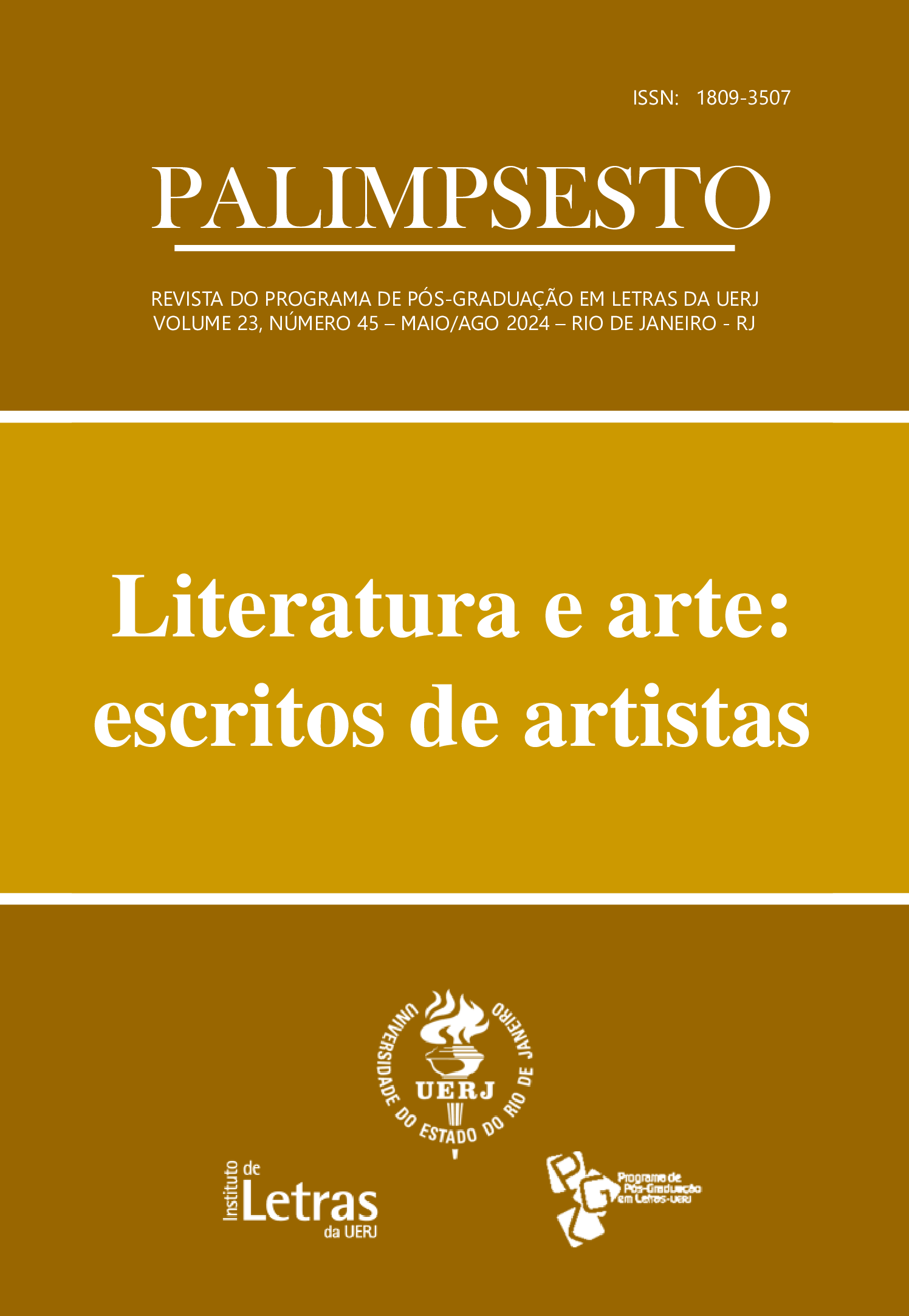A fantasmagoria do ver e o movimento do viver: notas sobre a experiência urbana em Poe, Woolf e Evaristo
DOI:
https://doi.org/10.12957/palimpsesto.2024.81768Palavras-chave:
fantasmagoria, flâneur, Woolf, Poe, Evaristo.Resumo
O artigo busca aproximar a flânerie narrada no conto “O homem da multidão”, de Poe, e no ensaio “Street Haunting”, de Virginia Woolf, a partir de um regime de visão específico que se caracteriza pela prevalência do fantasmagórico. Testando essa hipótese, o texto avança para as particularidades de cada flânerie enquanto movimento pela cidade, lendo as situações narradas a partir sobretudo da leitura benjaminiana que associa fantasmagoria ao fetiche da mercadoria. Findo esse primeiro momento, apresenta-se nova perspectiva de movimento na e da cidade a partir do conto “O cooper de Cida”, de Conceição Evaristo, que prescinde de qualquer elemento fantasmagórico e, justamente nessa ausência, enseja novas leituras sobre a relação entre ritmo e existência na cidade.
Downloads
Referências
BAUDELAIRE, Charles. Sobre a modernidade. São Paulo: Editora Paz e Terra, 1996
BENJAMIN, Walter. A obra de arte na época de sua reprodutibilidade técnica. In: Obras escolhidas: Magia e técnica, arte e política. São Paulo: Brasiliense, 1994, p. 165-196
BENJAMIN, Walter. Baudelaire e a Modernidade. Belo Horizonte: Autêntica Editora, 2015.
BENJAMIN, Walter. Passagens. Belo Horizonte: Editora UFMG, 2009.
EVARISTO, Conceição. Olhos d’água. 1ªed. Rio de Janeiro: Pallas, 2016.
MARX, K. Cadernos de Paris; Manuscritos econômicos-filosóficos. 1.ed. São Paulo: Expressão Popular, 2015.
MARX, K. O capital: crítica da economia política. Boitempo, 2013
POE, Edgar Alan. Histórias Extraordinárias. São Paulo: Companhia das Letras, 2017
REEVES, Abbie. Haunting History: Virginia Woolf, Vivian Maier, and the Twentieth-Century Flâneuse. Tese submetida ao Department of English Language & Literature. Chicago: The University of Chicago, 2019. Disponível em: https://knowledge.uchicago.edu/record/2502. Acesso em: 20 ago. 2023.
SANTOS, Milton. A Natureza do Espaço: Técnica e Tempo, Razão e Emoção. 4ª ed. São Paulo: Editora da Universidade de São Paulo, 2006.
SAQUET, Marcos Aurelio; DA SILVA, Sueli Santos. MILTON SANTOS: CONCEPÇÕES DE GEOGRAFIA, ESPAÇO E TERRITÓRIO / MILTON SANTOS: GEOGRAPHY CONCEPTIONS, SPACE AND TERRITORY. Geo UERJ, [S. l.], v. 2, n. 18, p. 24 à 42, 2011. Disponível em: https://www.e-publicacoes.uerj.br/geouerj/article/view/1389. Acesso em: 10 jan. 2024.
SHAYA, Gregory. The Flâneur, the Badaud, and the Making of a Mass Public in France, circa 1860-1910. American Historical Review. V. 109, n. 1, p. 41–77, fev. 2004
SIBILIA, Paula. O show do Eu. 2ª ed. Rio de Janeiro: Contraponto, 2016
SIMMEL, Georg. A metrópole e a vida mental. In: VELHO, Otávio Guilherme (org.). O fenômeno urbano. Rio de Janeiro: Zahar Editores, 1973.
SOTRATTI, Marcelo Antônio. Espaço. In: REZENDE, Maria Beatriz; GRIECO, Bettina; TEIXEIRA, Luciano; THOMPSON, Analucia (Orgs.). Dicionário IPHAN de Patrimônio Cultural. Rio de Janeiro, Brasília: IPHAN/DAF/Copedoc, 2015. Disponível em: http://portal.iphan.gov.br/dicionarioPatrimonioCultural/detalhes/62/espaco. Acesso em: 10 jan. 2024
TAYLOR, Charles. Sources of the self: the making of the modern identity. Cambridge: Harvard University Press, 2001
WOLFF, Janet. The Invisible Flâneuse. Women and the Literature of Modernity. Theory, Culture & Society, [S.L.], v. 2, n. 3, p. 37-46, nov. 1985. SAGE Publications. http://dx.doi.org/10.1177/0263276485002003005.
WOOLF, Virginia. Street Haunting: A London Adventure. In: Bradshaw, David (org.). Selected Essays. Oxford: Oxford University Press, 2008. p. 325-341
ZIZEK, Slavoj. Como ler Lacan. Tradução: Maria Luiza X. de A. Borges. Rio de Janeiro: Editora Zahar, 2010
Downloads
Publicado
Como Citar
Edição
Seção
Licença
A revista Palimpsesto publica artigos e resenhas inéditos, referentes as áreas de Letras e Linguística. Publica volumes mistos e/ou temáticos, com artigos e resenhas em português, inglês, espanhol e francês.
Autores mantêm os direitos autorais e concedem à revista o direito de primeira publicação, com o trabalho simultaneamente licenciado sob a Licença Creative Commons Attribution, que permite o compartilhamento do trabalho com reconhecimento da autoria e publicação inicial nesta revista.

Palimpsesto utiliza uma Licença Creative Commons - Atribuição-NãoComercial 4.0 Internacional.







